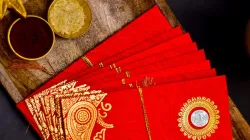Know 7 reasons why Indians add one-rupee coin in money gifting
Know the cultural significance behind Indians adding a one-rupee coin in money gifting. Explore seven compelling reasons behind this traditional gesture.

New Delhi:
In India, the act of gift-giving isn't just about exchanging material possessions, it's a profound expression of kindness and goodwill that transcends generations and communities. According to Dr. Jai Madaan, celebrity astrologer and motivational speaker, the tradition has embedded the practice of Shagun, a monetary gift symbolising good fortune and blessings for the recipient. What makes this tradition particularly unique is the addition of a humble one-rupee coin, signifying much more than its monetary value. Here are seven reasons why Indians incorporate this symbolic gesture into their money gifting.
- The Inauspicious Shunya: Hinduism emphasises on the cyclical tradition of life and death where 'zero' (shunya) indicates the end and 'one' is the beginning of something new. Ends are associated with negativity and beginnings with optimism. Giving money as a gift in numbers ending with zero, like 500, 1000, and so on, has ominous implications. So an extra rupee is added to ensure a fresh start.
- A New Beginning: Beliefs play paramount importance in traditions. Shagun is given on auspicious occasions like weddings, birthdays, rice, and sacred thread ceremonies. The celebrations concur with the belief in new beginnings. The 'one-rupee' is the symbol of renewed hope for the receiver, who is embarking on a new phase of life.
- A Wholesome Debt: Festivals and gatherings are good opportunities to foster and strengthen communal ties. This was especially prevalent in the days of forefathers. To encourage this community feeling, the additional 'one-rupee' was seen as a benign debt on the receiver's part. They had to repay it by accepting and attending the giver's festivals whenever the time came, ensuring a continuum in social relations.
- Draupadi's Akshaya Patra: Like Lord Krishna's boon of a vessel to Draupadi that would always have some extra anna (rice) for feeding everyone, the 'one-rupee' signifies a bit of leftover money for the receiver as well. The extra amount becomes a symbol of hope that difficult times will pass.
- Undivided Against All Odds: In the olden days, social gatherings were generally limited to marriages. Guests blessed the newlyweds to be united against all challenges. It manifested into the idea of gifting a sum of money that was not an 'even' number and could not be equally divided. This was to ensure that the couple did not quarrel over wealth and prospered together instead.
- The Auspicious Metallic Coin: The additional rupee of Shagun is always a coin because they are made of metal or Dhaatu. The human body is constituted by the Ashtadhaatu or 'eight elements'. Metals are propitious and a symbol of Goddess Lakshmi, the Hindu deity of wealth. Gold and silver coins were given as gifts in the past before the minting of steel and copper coins. Therefore, the gifting of a metallic coin adds to the holiness of the festivity.
- A Seedling That Blooms: Shagun is given with the hope that it is utilised for the benefit of the receiver. However, the extra coin is for investment. Like the popular tale of an enterprising boy who made a fortune from a paise, it also encourages the receiver's intellectual capacity to make a lasting impact from small but steady efforts.
(with IANS inputs)
ALSO READ: When is Chaitra Navratri 2024? Know the start and end date, muhurat, puja rituals, and significance
